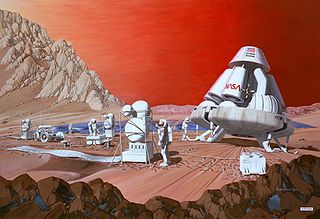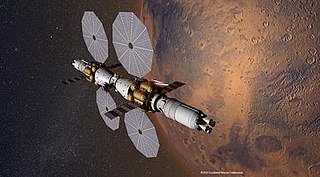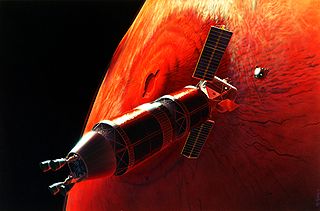 W
WA human mission to Mars has been the subject of science fiction since the 1880s, and of aerospace engineering and scientific proposals since the late 1940s. Plans include landing on Mars for exploration at a minimum, with some considering exploring its moons Phobos and Deimos. Longterm proposals have included sending settlers and starting terraforming of the planet.
 W
WThis list of crewed Mars mission plans is a listing of concept studies for a crewed mission to Mars during the 20th and 21st centuries. It is limited to studies done with engineering and scientific knowledge about the capabilities of then current technology, typically for high-budget space agencies like NASA. Mission profiles include crewed flybys, crewed landers, or other types of Mars system encounter strategies.
 W
WThe Aurora programme is a human spaceflight programme of the European Space Agency (ESA) established in 2001. The objective is to formulate and then to implement a European long-term plan for exploration of the Solar System using robotic spacecraft and human spaceflight to investigate bodies holding promise for traces of life beyond the Earth.
 W
WAustere Human Missions to Mars is a concept for a human mission to Mars by the United States space agency, NASA. Released in 2009, it proposed a modified and even less costly version of Design Reference Architecture (DRA) 5.0, itself a combination of nearly 20 years of Mars planning design work. The mission profile was for a conjunction class with a long surface stay, pre-deployed cargo, aerocapture and propulsive capture, and some in-situ resource production. As of 2015, the concept had not yet been adapted to the Space Launch System that replaced NASA's Constellation program in 2011.
 W
WThe Case for Mars: The Plan to Settle the Red Planet and Why We Must is a nonfiction science book by Robert Zubrin, first published in 1996, and revised and updated in 2011.
 W
WThe Caves of Mars Project was an early 2000s program funded through Phase II by the NASA Institute for Advanced Concepts to assess the best place to situate the research and habitation modules that a human mission to Mars would require. The final report was published in mid 2004.
 W
WThe hypothetical colonization of Mars has received interest from public space agencies and private corporations, and has received extensive treatment in science fiction writing, film, and art.
 W
WThe Constellation program is a cancelled crewed spaceflight program developed by NASA, the space agency of the United States, from 2005 to 2009. The major goals of the program were "completion of the International Space Station" and a "return to the Moon no later than 2020" with a crewed flight to the planet Mars as the ultimate goal. The program's logo reflected the three stages of the program: the Earth (ISS), the Moon, and finally Mars—while the Mars goal also found expression in the name given to the program's booster rockets: Ares. The technological aims of the program included the regaining of significant astronaut experience beyond low Earth orbit and the development of technologies necessary to enable sustained human presence on other planetary bodies.
 W
WCrewed Mars rovers are Mars rovers for transporting people on the planet Mars, and have been conceptualized as part of human missions to that planet.
 W
WThe Deep Space Transport (DST), also called Mars Transit Vehicle, is a crewed interplanetary spacecraft concept by NASA to support science exploration missions to Mars of up to 1,000 days. It would be composed of two elements: an Orion capsule and a propelled habitation module. As of late 2019, the DST is still a concept to be studied, and NASA has not officially proposed the project in an annual U.S. federal government budget cycle. The DST vehicle would depart and return from the Lunar Gateway to be serviced and reused for a new Mars mission.
 W
WIn orbital mechanics, a free-return trajectory is a trajectory of a spacecraft traveling away from a primary body where gravity due to a secondary body causes the spacecraft to return to the primary body without propulsion.
 W
WInspiration Mars Foundation is a defunct American nonprofit organization founded by Dennis Tito that in 2013 proposed to launch a crewed mission to flyby Mars in January 2018, or 2021 if they missed the first synodic opportunity in 2018.
 W
WMars Base Camp (MBC) is a crewed Mars laboratory orbiter concept under study that was commissioned by NASA from Lockheed Martin in US. It would use both future and proven concepts as well as the Orion MPCV, also built by Lockheed Martin.
 W
WThe NASA Mars Design Reference Mission ("DRM") refer to a series of NASA conceptual design studies of the missions to send humans to Mars. The related term, Design Reference Architecture (DRA), refers to the entire sequences of missions and supporting infrastructure.
 W
WMars Direct is a proposal for a human mission to Mars which purports to be both cost-effective and possible with current technology. It was originally detailed in a research paper by Martin Marietta engineers Robert Zubrin and David Baker in 1990, and later expanded upon in Zubrin's 1996 book The Case for Mars. It now serves as a staple of Zubrin's speaking engagements and general advocacy as head of the Mars Society, an organization devoted to the colonization of Mars.
 W
WThe Mars Excursion Module (MEM) was a spacecraft proposed by NASA in the 1960s for use in a human mission to Mars, and this can refer to any number of studies by corporations and spaceflight centers for Mars landers. However, primarily a MEM referred to a combination of a Manned Mars lander, short-stay surface habitat, and Mars ascent stage. Variations on a MEM included spacecraft designs like an uncrewed Mars surface cargo delivery, and there was a MEM lander that combined a communications center, living habitat, and laboratory.
 W
WThe Mars Institute is an international non-governmental organization created with the goals of advancing the scientific study and exploration of Mars, conducting peer-reviewed research, and educating the public about Mars exploration. It was incorporated as a non-profit corporation in both United States and Canada in 2002.
 W
WMars orbit rendezvous (MOR) is a space travel concept where two spacecraft meet up and/or dock in Mars orbit. For example, one vehicle takes off from Mars, such as a Martian ascent stage, and does a rendezvous in Mars orbit with another spacecraft. Applied to a Mars sample return or human mission to Mars, it allows much less weight to be sent to the surface and back into orbit, because the fuel needed to travel back to Earth is not landed on the planet. It has also been proposed for uncrewed Mars sample return plans.
 W
WThe Mars Project is a 1952 non-fiction scientific book by the German rocket physicist, astronautics engineer and space architect, Wernher von Braun. It was translated from the original German by Henry J. White and first published in English by the University of Illinois Press in 1953.
 W
WMars to Stay missions propose astronauts sent to Mars for the first time should intend to stay. Unused emergency return vehicles would be recycled into settlement construction as soon as the habitability of Mars becomes evident to the initial pioneers. Mars to Stay missions are advocated both to reduce cost and to ensure permanent settlement of Mars. Among many notable Mars to Stay advocates, former Apollo astronaut Buzz Aldrin has been particularly outspoken, suggesting in numerous forums "Forget the Moon, Let’s Head to Mars!" and, in June 2013, Aldrin promoted a crewed mission "to homestead Mars and become a two-planet species". In August 2015, Aldrin, in association with the Florida Institute of Technology, presented a "master plan", for NASA consideration, for astronauts, with a "tour of duty of ten years", to colonize Mars before the year 2040. The Mars Underground, Mars Homestead Project / Mars Foundation, Mars One, and Mars Artists Community advocacy groups and business organizations have also adopted Mars to Stay policy initiatives.
 W
WThe MARS-500 mission was a psychosocial isolation experiment conducted between 2007 and 2011 by Russia, the European Space Agency and China, in preparation for an unspecified future crewed spaceflight to the planet Mars. The experiment's facility was located at the Russian Academy of Sciences' Institute of Biomedical Problems (IBMP) in Moscow, Russia.
 W
WNASA Design Reference Mission 3.0 was a NASA study for a human space mission to the planet Mars in the 1990s. It was a plan for a human exploration architecture for Mars, and was released in 1998 as an addendum to the early design plans released in 1994. The plan is for a series of multiple launches to send various space transpiration, surface exploration hardware, and human crew to Mars, and to return the crew to Earth in the early 21st century. Various technologies are explored to launch the payloads into space, to send them to Mars, and to reduce overall weight of the mission by various technologies or techniques including nuclear, solar, aerobraking, and in-situ resource use.
 W
WProject Mars: A Technical Tale is a 2006 science fiction novel by German-American rocket physicist, Wernher von Braun (1912–1977), credited as Dr. Wernher von Braun. It was written by von Braun in German in 1949 and entitled Marsprojekt. Henry J. White (1892–1962) translated the book into English and it was published later by Apogee Books (Canada) in 2006 as Project Mars: A Technical Tale, almost thirty years after von Braun's death. The original German text remains unpublished.
 W
WThe Space Exploration Initiative was a 1989–1993 space public policy initiative of the George H. W. Bush administration.
 W
WTMK was the designation of a Soviet space exploration project to send a crewed flight to Mars and Venus without landing.
 W
WTorpor Inducing Transfer Habitat For Human Stasis To Mars is a hibernation system proposed by SpaceWorks Engineering in 2013. The proposed system would significantly reduce the cost of a human expedition to Mars by placing the crew in extended torpor for 90 days to 6 months. Traveling during hibernation would reduce astronauts' metabolic functions as well as minimize requirements for life support during multi-missions.
 W
WThe Vision for Space Exploration (VSE) was a plan for space exploration announced on January 14, 2004 by President George W. Bush. It was conceived as a response to the Space Shuttle Columbia disaster, the state of human spaceflight at NASA, and as a way to regain public enthusiasm for space exploration. It was replaced by the space policy of the Barack Obama administration in June 2010.